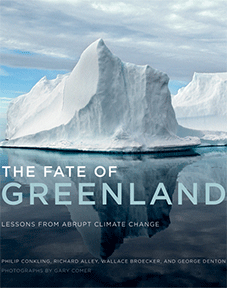By Benjamin Franklin Martin
The Fate of Greenland, winner of the 2012 Phi Beta Kappa Award in Science, had its origin in questions posed by Gary Comer, best known as the founder of the Lands’ End mail order company. Comer was a transoceanic sailor of uncommon ability, and in 2001, he became the first to cross the Northwest Passage without assistance from an icebreaker, doing so in record time. The sight of open water in the Arctic impressed on him the reality of global warming. After consulting experts, above all, glaciologist Richard Alley, oceanographer Wallace Broecker, and geologist George Denton, he dedicated his wealth to sponsor field research in Greenland, where they argued that explanations should be sought. Eventually, they attracted another seventy-four “Comer Fellows” to join them.
The knowledge of Ice Ages, and therefore the recognition that the earth has passed through manifold climate changes, dates only from the early nineteenth century. Since then, scientists have identified three major factors that collectively influence the climate: “(Milutin) Milankovitch cycles,” which chart the earth’s precession (pole wobbling), obliquity (polar tilt) and eccentricity (orbit around the sun), the “ocean-conveyor hypothesis,” which measures sea currents flowing around the earth, especially the Atlantic Meridional Overturning Circulation, and the level of “greenhouse gases,” in the earth’s atmosphere, the percentages of methane, nitrous oxide, and especially carbon dioxide.
The alteration of warm and cold periods was long thought to have occurred slowly and smoothly, requiring eons of time. Discoveries from recent decades have demonstrated, however, that during the last 100,000 years alone, there have been twenty-four onsets and reversals of glaciation, often occurring abruptly. The most recent was the shift from the “Medieval Warm” period (c. 950 to c. 1300), when average conditions in Europe were much like today’s, to the “Little Ice Age” (c. 1300 to c. 1850), when average temperatures were sometimes as much as ten degrees Fahrenheit lower. Both the scientific and the historical evidence strongly suggest that the change took less three decades and had such devastating effects upon the society and economy that Europeans were easy prey for the new plague of Black Death when it appeared in 1348.
Why carry out the field research in Greenland? The earth’s largest island is almost completely covered by an enormous ice sheet, measuring more than 660,000 square miles in extent with an average depth of 1.25 miles. During the Medieval Warm period, Norsemen successfully settled its coasts but were driven away by the onset of the Little Ice Age. Cores drilled through the ice sheet reveal drastic and abrupt climate shifts—which precipitated changes around the globe. So watch Greenland and read the future.
For the evidence there suggests that another abrupt climate shift is looming. Warming temperatures, the result of increased levels of carbon dioxide, have increased the melting rate of the Greenland ice sheet and threaten to raise sea levels. If so, the influx of fresh water into the north Atlantic will eventually produce uncertain effects on the Meridional Overturning Circulation. Whatever the changes, history shows that adapting to them will be difficult.
Gary Comer died in 2006, but his influence is assured through this book. The scientists he sponsored explain their discoveries with admirable clarity, and the text is accompanied by his extraordinary photographs.
Benjamin Franklin Martin (ΦΒΚ, Davidson College, 1969) is the Price Professor of History at Louisiana State University and a resident member of the Beta of Louisiana Chapter of Phi Beta Kappa.




